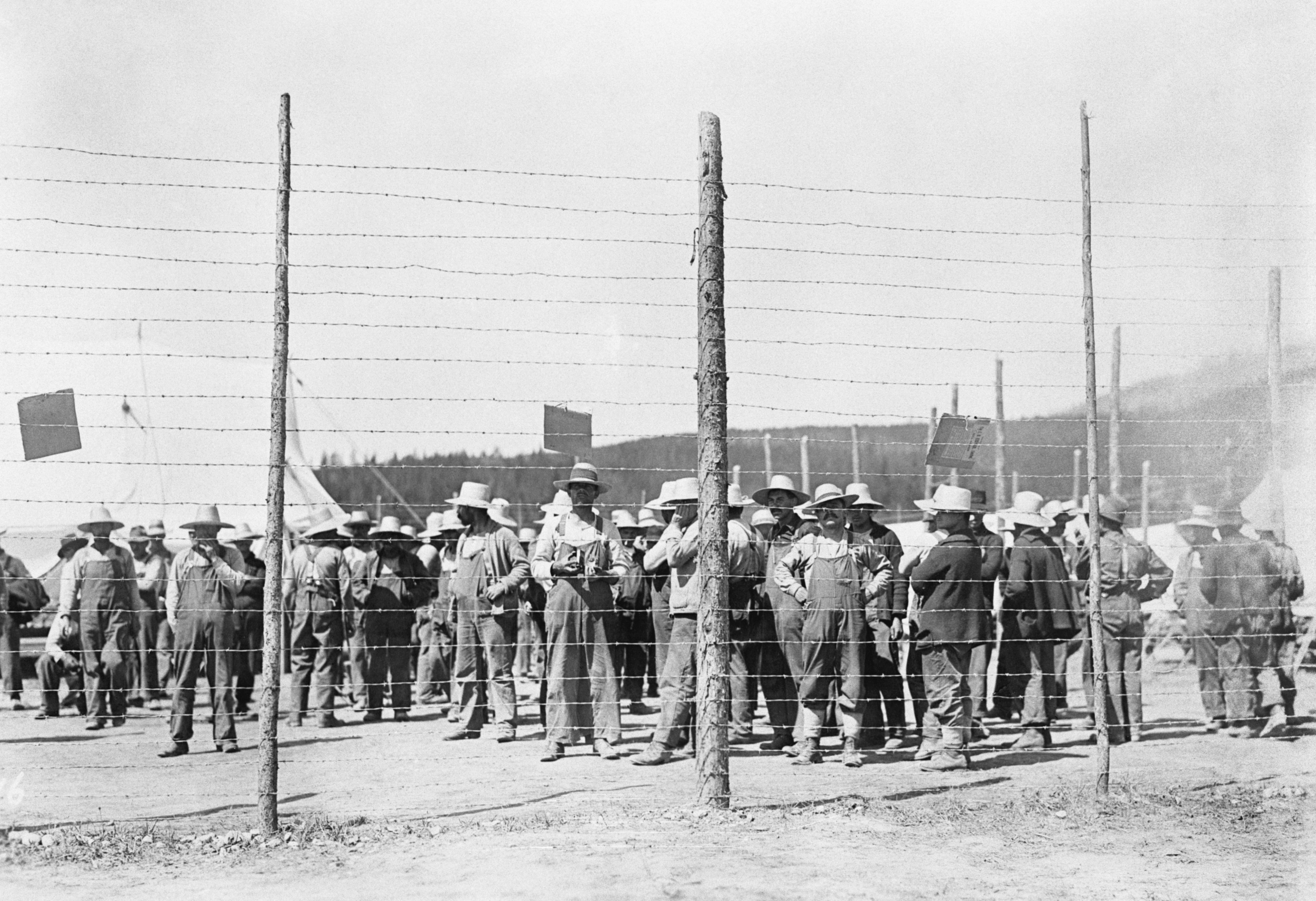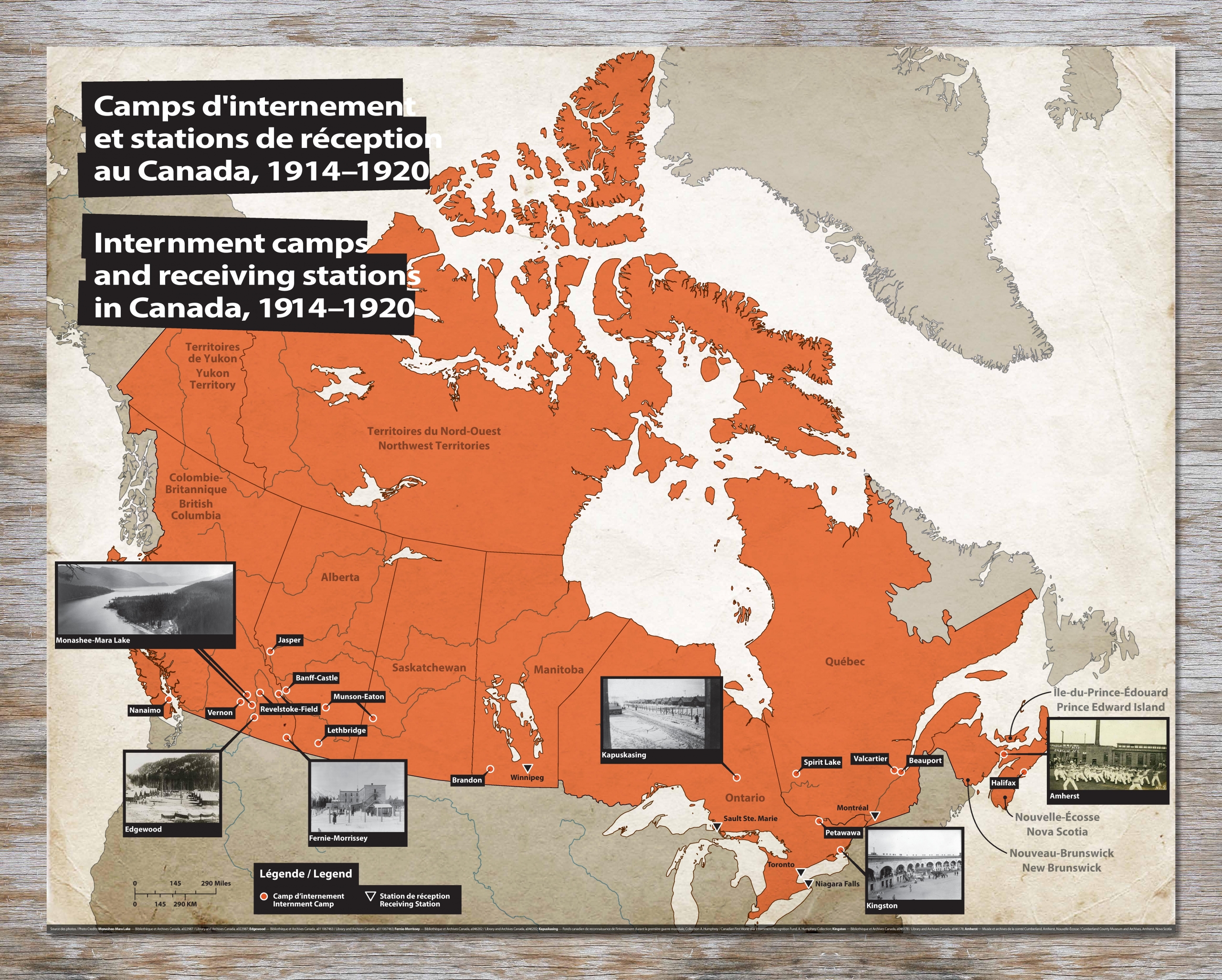Internees at the internment camp in Castle Mountain
Photograph
Image
Video
Audio
 Activities
Activities
LOOK
Look closely at the first photograph and complete the following sentences:
- I see… [describe what you see in the photograph]
- I think… [describe what you think is happening in the photograph]
- I wonder… [describe what you wonder about the people in the photograph]
LOOK
Look at the map on the second slide. It shows the known locations of internment camps in Canada during the First World War. How many camps are shown? Does the number of camps surprise you? Explain why or why not.
THINK
Look at this photograph. Who do see? Who do you think was interned these camps? To verify your answer, read the Historical Context below.
DO
Look at the map of internment camps on the second slide and the list of locations here. What do you notice about the buildings used to house internees? Were they specifically built for internees? Take the perspective of an internee, how do you think it felt to live in some of these places?
Details
 Materials
Materials - Photograph
Historical Context
Choose one of the three levels below to match your needs.
- The War Measures Act restricted civil liberties for hundreds of thousands of Canadians, censored the media, required registration for certain groups, and suspended freedom of expression and association (the freedom to join and leave groups voluntarily).
- Around 8,500 “enemy aliens” (people from countries at war with Canada) were arrested and detained without cause or due process between 1914 and 1920. The majority of internees were of Ukrainian origin.
- Internees were sent to the Office of Internment Operations, and were placed in more than 24 temporary detention centres and camps. The map on the second slide indicates the locations of known detention centres. Castle Mountain is included in the Banff-Castle label.
The War Measures Act restricted civil liberties for hundreds of thousands of Canadians. It also imposed censorship, required registration for certain groups, and suspended freedom of expression and association, as well as legal protections.
Around 8,500 people from countries at war with Canada were arrested and detained, without cause or due process, between 1914 and 1920. The majority of internees were of Ukrainian origin.
In some places, “enemy aliens” were required to register with authorities, to help determine whether they posed a risk. More than 80,000 registered, and around 8,500 of these were interned.
Internees were delivered to the Office of Internment Operations, and were held at more than 24 temporary detention centres and camps. The map on the second slide indicates the locations of known detention centres. Castle Mountain is included in the Banff-Castle label.
The War Measures Act restricted civil liberties for hundreds of thousands of Canadians. It also imposed censorship, required registration for certain groups, and suspended freedom of expression and association, as well as legal protections.
The Act particularly affected Canadians from countries at war with the British Empire, who were labelled “enemy aliens.” Around 8,500 of them were arrested and detained without cause or due process between 1914 and 1920. The majority of internees were of Ukrainian origin.
In some places, “enemy aliens” were required to register with authorities, to help determine whether they posed a risk. More than 80,000 registered, and around 8,500 of these were interned.
The reasons for internment were many — and often arbitrary. They included being jobless, committing a legal infraction, or trying to leave the country.
Internees were delivered to the Office of Internment Operations, and were held at more than 24 temporary detention centres and camps. The map on the second slide indicates sites identified to date. Castle Mountain is included in the Banff-Castle label.
The last camps closed in February 1920, 15 months after the end of the war.
- The War Measures Act restricted civil liberties for hundreds of thousands of Canadians, censored the media, required registration for certain groups, and suspended freedom of expression and association (the freedom to join and leave groups voluntarily).
- Around 8,500 “enemy aliens” (people from countries at war with Canada) were arrested and detained without cause or due process between 1914 and 1920. The majority of internees were of Ukrainian origin.
- Internees were sent to the Office of Internment Operations, and were placed in more than 24 temporary detention centres and camps. The map on the second slide indicates the locations of known detention centres. Castle Mountain is included in the Banff-Castle label.
The War Measures Act restricted civil liberties for hundreds of thousands of Canadians. It also imposed censorship, required registration for certain groups, and suspended freedom of expression and association, as well as legal protections.
Around 8,500 people from countries at war with Canada were arrested and detained, without cause or due process, between 1914 and 1920. The majority of internees were of Ukrainian origin.
In some places, “enemy aliens” were required to register with authorities, to help determine whether they posed a risk. More than 80,000 registered, and around 8,500 of these were interned.
Internees were delivered to the Office of Internment Operations, and were held at more than 24 temporary detention centres and camps. The map on the second slide indicates the locations of known detention centres. Castle Mountain is included in the Banff-Castle label.
The War Measures Act restricted civil liberties for hundreds of thousands of Canadians. It also imposed censorship, required registration for certain groups, and suspended freedom of expression and association, as well as legal protections.
The Act particularly affected Canadians from countries at war with the British Empire, who were labelled “enemy aliens.” Around 8,500 of them were arrested and detained without cause or due process between 1914 and 1920. The majority of internees were of Ukrainian origin.
In some places, “enemy aliens” were required to register with authorities, to help determine whether they posed a risk. More than 80,000 registered, and around 8,500 of these were interned.
The reasons for internment were many — and often arbitrary. They included being jobless, committing a legal infraction, or trying to leave the country.
Internees were delivered to the Office of Internment Operations, and were held at more than 24 temporary detention centres and camps. The map on the second slide indicates sites identified to date. Castle Mountain is included in the Banff-Castle label.
The last camps closed in February 1920, 15 months after the end of the war.
Summary
- The War Measures Act restricted civil liberties for hundreds of thousands of Canadians, censored the media, required registration for certain groups, and suspended freedom of expression and association (the freedom to join and leave groups voluntarily).
- Around 8,500 “enemy aliens” (people from countries at war with Canada) were arrested and detained without cause or due process between 1914 and 1920. The majority of internees were of Ukrainian origin.
- Internees were sent to the Office of Internment Operations, and were placed in more than 24 temporary detention centres and camps. The map on the second slide indicates the locations of known detention centres. Castle Mountain is included in the Banff-Castle label.
Essential
The War Measures Act restricted civil liberties for hundreds of thousands of Canadians. It also imposed censorship, required registration for certain groups, and suspended freedom of expression and association, as well as legal protections.
Around 8,500 people from countries at war with Canada were arrested and detained, without cause or due process, between 1914 and 1920. The majority of internees were of Ukrainian origin.
In some places, “enemy aliens” were required to register with authorities, to help determine whether they posed a risk. More than 80,000 registered, and around 8,500 of these were interned.
Internees were delivered to the Office of Internment Operations, and were held at more than 24 temporary detention centres and camps. The map on the second slide indicates the locations of known detention centres. Castle Mountain is included in the Banff-Castle label.
In-Depth
The War Measures Act restricted civil liberties for hundreds of thousands of Canadians. It also imposed censorship, required registration for certain groups, and suspended freedom of expression and association, as well as legal protections.
The Act particularly affected Canadians from countries at war with the British Empire, who were labelled “enemy aliens.” Around 8,500 of them were arrested and detained without cause or due process between 1914 and 1920. The majority of internees were of Ukrainian origin.
In some places, “enemy aliens” were required to register with authorities, to help determine whether they posed a risk. More than 80,000 registered, and around 8,500 of these were interned.
The reasons for internment were many — and often arbitrary. They included being jobless, committing a legal infraction, or trying to leave the country.
Internees were delivered to the Office of Internment Operations, and were held at more than 24 temporary detention centres and camps. The map on the second slide indicates sites identified to date. Castle Mountain is included in the Banff-Castle label.
The last camps closed in February 1920, 15 months after the end of the war.


